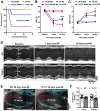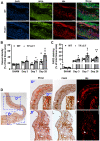Tissue factor cytoplasmic domain exacerbates post-infarct left ventricular remodeling via orchestrating cardiac inflammation and angiogenesis
- PMID: 34646369
- PMCID: PMC8490508
- DOI: 10.7150/thno.63354
Tissue factor cytoplasmic domain exacerbates post-infarct left ventricular remodeling via orchestrating cardiac inflammation and angiogenesis
Abstract
The coagulation protein tissue factor (TF) regulates inflammation and angiogenesis via its cytoplasmic domain in infection, cancer and diabetes. While TF is highly abundant in the heart and is implicated in cardiac pathology, the contribution of its cytoplasmic domain to post-infarct myocardial injury and adverse left ventricular (LV) remodeling remains unknown. Methods: Myocardial infarction was induced in wild-type mice or mice lacking the TF cytoplasmic domain (TF∆CT) by occlusion of the left anterior descending coronary artery. Heart function was monitored with echocardiography. Heart tissue was collected at different time-points for histological, molecular and flow cytometry analysis. Results: Compared with wild-type mice, TF∆CT had a higher survival rate during a 28-day follow-up after myocardial infarction. Among surviving mice, TF∆CT mice had better cardiac function and less LV remodeling than wild-type mice. The overall improvement of post-infarct cardiac performance in TF∆CT mice, as revealed by speckle-tracking strain analysis, was attributed to reduced myocardial deformation in the peri-infarct region. Histological analysis demonstrated that TF∆CT hearts had in the infarct area greater proliferation of myofibroblasts and better scar formation. Compared with wild-type hearts, infarcted TF∆CT hearts showed less infiltration of proinflammatory cells with concomitant lower expression of protease-activated receptor-1 (PAR1) - Rac1 axis. In particular, infarcted TF∆CT hearts displayed markedly lower ratios of inflammatory M1 macrophages and reparative M2 macrophages (M1/M2). In vitro experiment with primary macrophages demonstrated that deletion of the TF cytoplasmic domain inhibited macrophage polarization toward the M1 phenotype. Furthermore, infarcted TF∆CT hearts presented markedly higher peri-infarct vessel density associated with enhanced endothelial cell proliferation and higher expression of PAR2 and PAR2-associated pro-angiogenic pathway factors. Finally, the overall cardioprotective effects observed in TF∆CT mice could be abolished by subcutaneously infusing a cocktail of PAR1-activating peptide and PAR2-inhibiting peptide via osmotic minipumps. Conclusions: Our findings demonstrate that the TF cytoplasmic domain exacerbates post-infarct cardiac injury and adverse LV remodeling via differential regulation of inflammation and angiogenesis. Targeted inhibition of the TF cytoplasmic domain-mediated intracellular signaling may ameliorate post-infarct LV remodeling without perturbing coagulation.
Keywords: adverse left ventricular remodeling; angiogenesis; inflammation; myocardial infarction; tissue factor cytoplasmic domain.
© The author(s).
Conflict of interest statement
Competing Interests: The authors have declared that no competing interest exists.
Figures









Similar articles
-
Macrophage-Expressed Coagulation Factor VII Promotes Adverse Cardiac Remodeling.Circ Res. 2024 Sep 27;135(8):841-855. doi: 10.1161/CIRCRESAHA.123.324114. Epub 2024 Sep 5. Circ Res. 2024. PMID: 39234697
-
Lgr4 Governs a Pro-Inflammatory Program in Macrophages to Antagonize Post-Infarction Cardiac Repair.Circ Res. 2020 Sep 25;127(8):953-973. doi: 10.1161/CIRCRESAHA.119.315807. Epub 2020 Jun 30. Circ Res. 2020. PMID: 32600176
-
Role of protease activated receptor 1 and 2 signaling in hypoxia-induced angiogenesis.Arterioscler Thromb Vasc Biol. 2007 Jun;27(6):1456-62. doi: 10.1161/ATVBAHA.107.142539. Epub 2007 Mar 15. Arterioscler Thromb Vasc Biol. 2007. PMID: 17363687
-
The Protective Role of TREM2 in the Heterogenous Population of Macrophages during Post-Myocardial Infarction Inflammation.Int J Mol Sci. 2023 Mar 14;24(6):5556. doi: 10.3390/ijms24065556. Int J Mol Sci. 2023. PMID: 36982629 Free PMC article. Review.
-
Properties and Functions of Fibroblasts and Myofibroblasts in Myocardial Infarction.Cells. 2022 Apr 20;11(9):1386. doi: 10.3390/cells11091386. Cells. 2022. PMID: 35563692 Free PMC article. Review.
Cited by
-
Berberine: A Review of its Pharmacokinetics Properties and Therapeutic Potentials in Diverse Vascular Diseases.Front Pharmacol. 2021 Nov 3;12:762654. doi: 10.3389/fphar.2021.762654. eCollection 2021. Front Pharmacol. 2021. PMID: 35370628 Free PMC article. Review.
-
Nanomedicine-Based Therapeutics for Myocardial Ischemic/Reperfusion Injury.Adv Healthc Mater. 2023 Aug;12(20):e2300161. doi: 10.1002/adhm.202300161. Epub 2023 Apr 10. Adv Healthc Mater. 2023. PMID: 36971662 Free PMC article. Review.
-
Cell-derived nanovesicles from mesenchymal stem cells as extracellular vesicle-mimetics in wound healing.Acta Pharm Sin B. 2023 May;13(5):1887-1902. doi: 10.1016/j.apsb.2022.10.022. Epub 2022 Nov 15. Acta Pharm Sin B. 2023. PMID: 37250164 Free PMC article.
-
The function of miRNAs in the immune system's inflammatory reaction to heart failure.Front Cardiovasc Med. 2024 Dec 2;11:1506836. doi: 10.3389/fcvm.2024.1506836. eCollection 2024. Front Cardiovasc Med. 2024. PMID: 39687084 Free PMC article. Review.
-
Exercise Training after Myocardial Infarction Attenuates Dysfunctional Ventricular Remodeling and Promotes Cardiac Recovery.Rev Cardiovasc Med. 2022 Apr 19;23(4):148. doi: 10.31083/j.rcm2304148. eCollection 2022 Apr. Rev Cardiovasc Med. 2022. PMID: 39076229 Free PMC article. Review.
References
-
- D'Alessandro E, Posma JJN, Spronk HMH, Ten Cate H. Tissue factor (:Factor VIIa) in the heart and vasculature: More than an envelope. Thromb Res. 2018;168:130–7. - PubMed
Publication types
MeSH terms
Substances
Grants and funding
LinkOut - more resources
Full Text Sources
Medical
Research Materials
Miscellaneous

